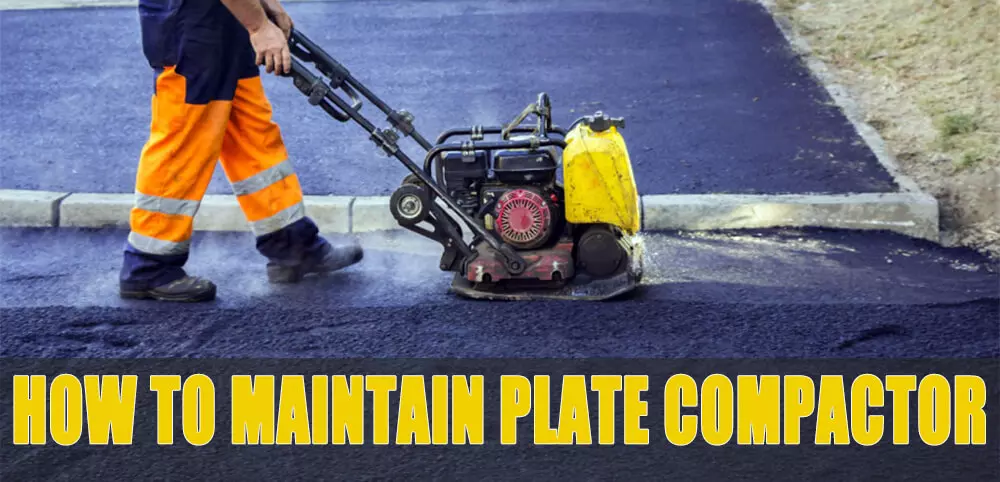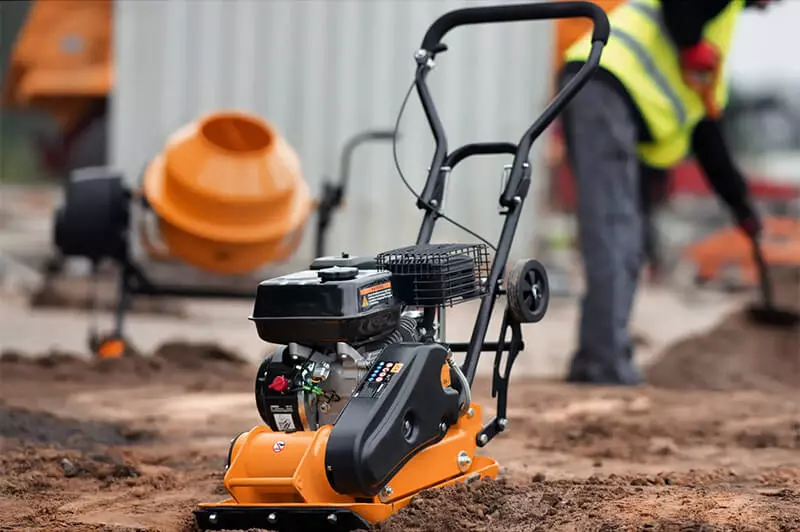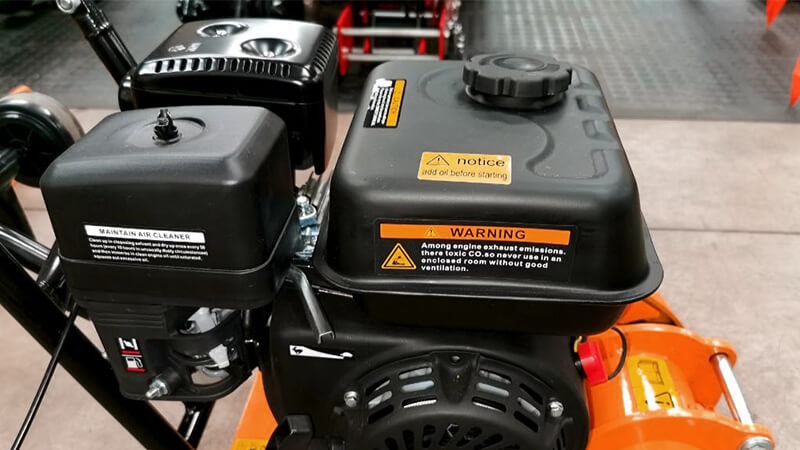24Feb 2024
table of contents

Maintaining your plate compactor is critical to this equipment's quality of work. Engines, belts and air filters are significant pieces of equipment that can cause failure and reduce the efficiency of the vibrating plate compactor if not appropriately maintained.
Here are some helpful tips for maintaining your plate compactor:
Cleaning compactor: The plates on the compactor must be kept clean. Ensure clear of detritus such as dirt, gravel, and adhered asphalt prior to use. During operations on asphalt, the vibrating action often results in the collection of rocks and debris, which can lead to detrimental effects on the plate compactor. By removing this debris, you reduce the chance of damaging the plate. Also make sure you are not using any flammable cleaners. If too much asphalt builds up, it may cause the plate to seize or damage the plate.
Check for any loose screws and nuts: These parts will loosen over time, so it is advisable to tighten them occasionally.
Check for damage: Check your concrete plate compactor for damage, especially on the drive belts and shock mounts.
Check fluid level: When doing this, the plate compactor is flat, so the fluid is measured correctly. When the amount of oil is insufficient, the bearings may wear out. With too much oil, the machine may slow down and lose efficiency.
Replace old fuel: In addition to checking the fluid level, it is essential to drain the fuel tank and replace it with new gasoline and oil. Gasoline octane ratings decrease over time. BISON recommends 91-octane gasoline and SAE10W30 oil for optimum performance.
Check clutch: If the clutch is loose, the transmission will lose its effect, weakening the compaction.
Check plate wearing: Shoe linings should be inspected for wear. Power transmission can become scarce if the shoes are worn, causing the plate to slip.
Check the air filter: Check the air filter for heavy dirt. This reduces the efficiency of the filter. Use an air compressor from the inside out to clean the air filter. Don't try to do it from the outside in.
Any new equipment requires an initial maintenance program to break in the various systems and constituent units properly. Carry out this singular, initial break-in maintenance after the machine has been operational for a period of between 20 to 30 hours.
After this initial phase, regular maintenance should follow.
Engine oil: After the operation has been ongoing for the initial 20 hours, drain the oil. Drain the oil after removing the oil stopper. Using an oil check gauge, add the recommended amount of oil and check the oil level.
Battery electrolyte: If installed - check the electrolyte level of the battery every month, and add distilled water when the level is low. The battery electrolyte evaporates, thus reducing its volume.
Insufficient electrolytes may damage the battery, and overflowing electrolytes may damage the bed.

The following steps are strongly recommended at the beginning and end of each 8 to 10-hour shift, whichever comes first.
Engine oil: Initiate each day of operation by checking the engine oil level. Insert the dipstick and check the full scale on the dipstick. Do not screw in the dipstick first. This will give false readings on the meter. Fill the oil dipstick with new oil.
Check: Does your engine operate on diesel or petrol? Incorrect fuel can seriously damage your engine. Make sure the water tank is complete at the beginning of each day. Shut off the engine before refueling. Clean the fuel cap before removing it, and fill the tank carefully. Do not top up with fuel. Clean around the fuel tank cap after refueling.
Air cleaner: Loosen the butterfly nut and remove the cleaner cap. Inspect and clean elements if necessary. Do not clean the inner filter. Install the cover and tighten the butterfly nuts.
Fastening hardware: Make sure all hardware is fully tightened and not missing or damaged.
The following steps are strongly recommended at the beginning and end of every 100-hour shift or month, Whichever comes first.
Engine oil
Subsequent to the first oil change (20 hours of operation):
Drain the oil entirely every 100 hours.
Fill with the appropriate amount of recommended oil.
Check the oil level with the oil check dipstick.
Oil filter
Start by replacing the oil filter following the initial 100 hours of operation. Subsequently, continue to change it after every additional 300 operational hours.
Air filter
Check and clean the air filter. It must be replaced if the filter looks dirty between the fins and is a dark off-white color.
Fuel filter
Start by replacing the oil filter following the initial 100 hours of operation. Subsequently, continue to change it after every additional 300 operational hours.
V belt
After 100 hours of usage, scrutinize the tension of the V-belt. Replace the V-belt if any indications of damage become apparent.
Timing belt
If installed - check the timing belt tension after 100 hours of operation. Adjust the timing belt tension if necessary. Replace it if any indications of damage become apparent.
Battery electrolyte
Check and top up the battery electrolyte monthly or after 100 hours of operation.

In addition to the routine checks executed daily, after every 20 hours, and each 100-hour block, we highly recommend performing the following inspection steps at the start and conclusion of either each 300-hour work period or every month, whichever comes first.
Oil filter
If installed - change the oil filter after 300 hours of operation (this is after the initial 100-hour change).
Vibratory shaft case oil
Drain the vibrating shaft case oil annually or after 300 hours of operation. Remove the drain plug carefully and the fill plug. Empty the current oil and then refill it to suggested volume as per manufacturer's guidelines.
Timing belt
If installed - replace the timing belt annually or after 300 hours of operation.
Benefits of plate compactor maintenance
Regular maintenance of your plate compactor has several benefits, including:
Proper maintenance will ensure your plate compactor runs at optimum levels. Regular inspection and cleaning can help identify and resolve issues that may affect performance. By addressing issues promptly, you can achieve better results.
A plate compactor is a significant investment; proper maintenance will help extend its life. Keeping it clean, lubricated and in good working order can prevent premature wear and damage to vital components. This raises the overall life of the plate compactor.
It may enable you to save money. Addressing minor complications immediately as they surface can prevent them from escalating into more substantial issues that necessitate expensive repairs.
Proper maintenance increases the safety of operating a plate compactor. Routine inspections are crucial for recognizing potential safety hazards. Loose or compromised parts, if left undetected, could precipitate accidents or injuries.
Use the correct amount and type of 10W-30 motor oil. While manipulating bearings, strive to maintain hand cleanliness to avoid inadvertently sparking corrosion.
If you maintain it regularly, this machine will last for years.
The presence of a water tank is fundamental for operating the plate compactor on asphalt and border surfaces.
Due to weight, frequency and motion, plate compactors can cause severe or fatal injury if misused.
Taking proper and regular care of your plate compactor will make it last longer, saving you money in the long run. Maintaining also helps avoid accidents and complete the job more quickly and efficiently.
With these tips, your plate compactor will run efficiently and extend the life of your machine.
BISON plate compactors are designed with sturdy materials and equipped with advanced technology to make them more durable and require less maintenance. Don’t let your construction project’s performance be hampered by plate compactor failure. So, are you ready to experience the BISON difference? Visit our website or call us today to make your job easier, safer, and more efficient.
inquiry form here
BISON BLOG, All the latest news and views from Bison Machinery.